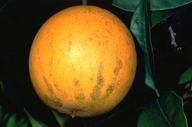It's been a dry year and you don't expect it, but there's been a lot of "tear staining" of fruit. It has become most apparent this spring with the dew along the coast and the humidity. I've had a number of calls from growers this year because it has downgraded their fruit. One 'Meyer' lemon grower has had virtually all of her fruit affected. Here's the word from the IPM website - http://www.ipm.ucdavis.edu/PMG/r107102111.html
Citrus
Anthracnose
Pathogen: Colletotrichum gloeosporioides
In this Guideline:
Symptoms
Symptoms of anthracnose on citrus include twig dieback, premature leaf drop, dark staining on fruit and postharvest fruit decay. Dying leaves and twigs become covered with dark fungal spores by which the pathogen spreads.
Anthracnose may blemish the rind tissue of mature Valencia and navel oranges, grapefruit, and occasionally lemon. The disorder affects mainly fruit on stressed trees with old, dead wood.
Comments on the Disease
The anthracnose fungus usually infects weakened twigs. The disease is most common during springs with prolonged wet periods and when significant rains occur later in the season than normal. During wet or foggy weather, anthracnose spores drip onto fruit, where they infect the rind and leave dull, reddish-to-green streaks on immature fruit and brown-to-black streaks on mature fruit (tear stains). Anthracnose tearstain often occurs with Septoria spot. The Septoria fungus itself and possibly certain environmental conditions may also cause tear staining. The stain cannot be washed off, but the disorder is generally not severe enough to require preventive actions. Certain conditions, however, such as applications of insecticidal soaps, which damage the protective wax on the fruit peel, can increase the severity of this disease.
Attached Images:
